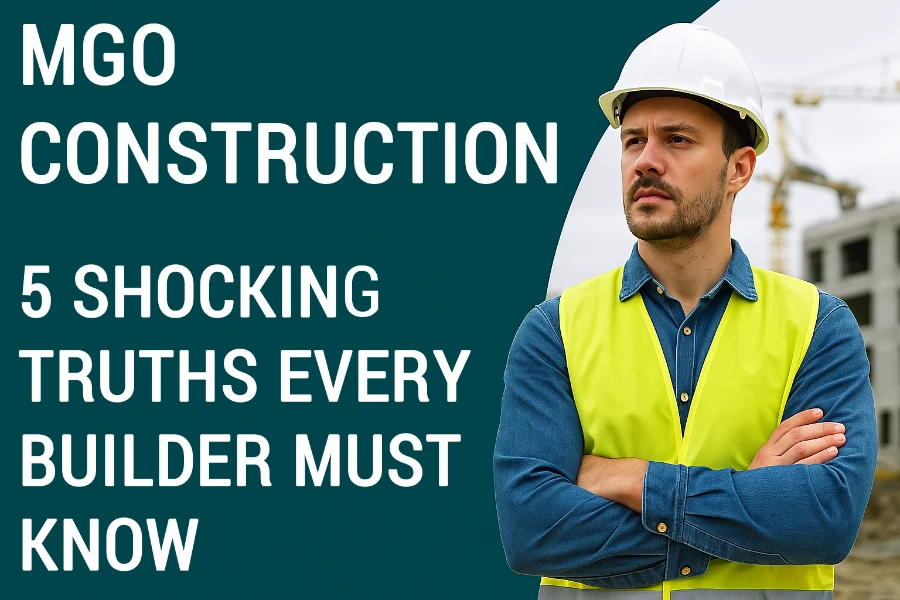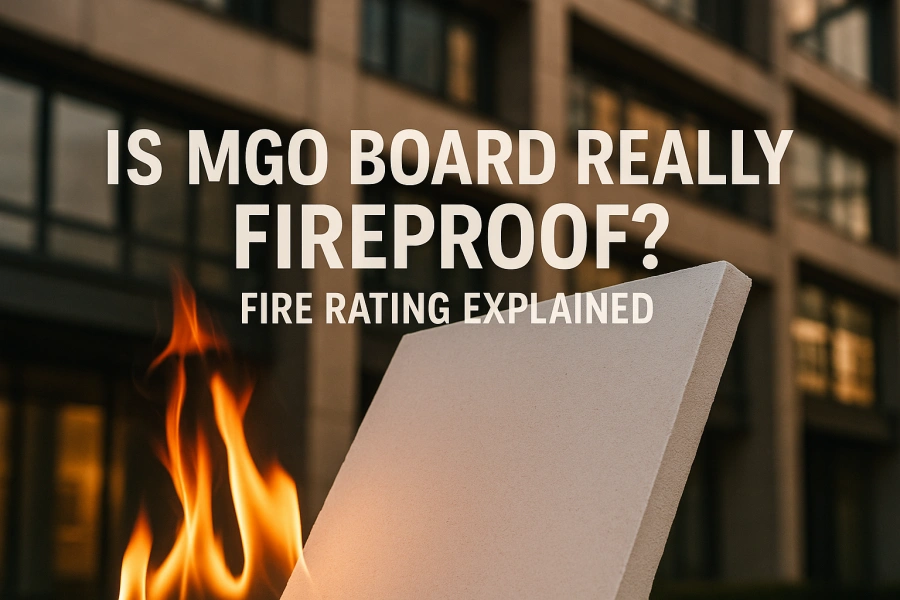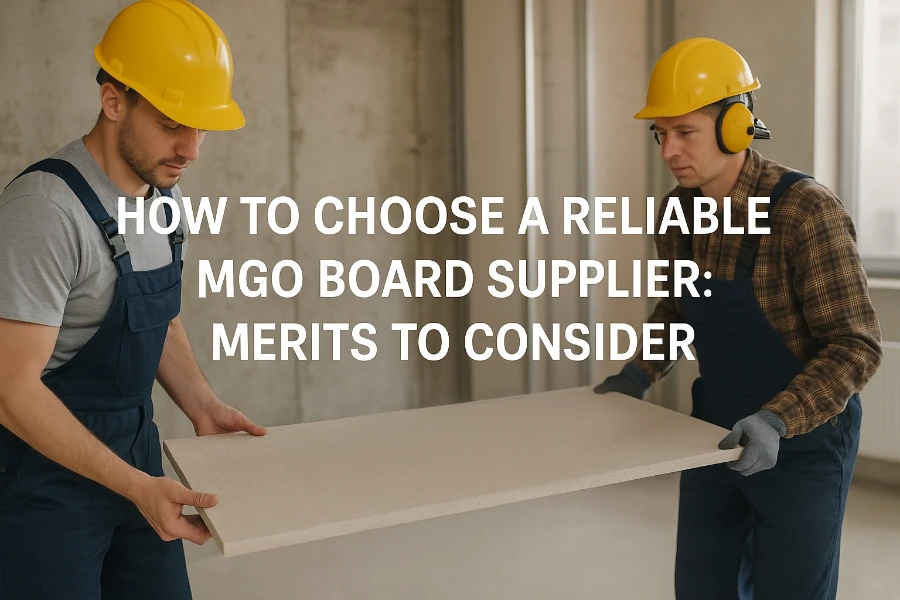Table of Contents
Ask Us Any Question
Introduction
In recent years, MGO construction has emerged as a disruptive force in the building industry. By using magnesium oxide (MgO) boards as a core material, architects and contractors are discovering a safer, stronger, and more sustainable alternative to conventional products like gypsum board, plywood, or fiber cement. Yet despite its growing popularity, many builders still lack a clear understanding of what MGO construction really offers—and what makes it so different from the materials they have relied on for decades.
This knowledge gap has led to several common misconceptions. Some assume that magnesium oxide boards are simply another version of drywall, while others believe they are too expensive or too limited in application. These misunderstandings prevent professionals from seeing the full potential of MGO construction and, in some cases, cause them to miss out on significant benefits for their projects.
The reality, however, is far more compelling. MGO boards have been extensively tested and applied across residential, commercial, and industrial projects worldwide. They provide an unmatched combination of fire safety, durability, environmental responsibility, and design flexibility. What is most surprising is how many of these advantages are not widely known—even among experienced builders.
In this article, we will uncover five shocking truths every builder must know about MGO construction. From fire resistance to cost efficiency and versatility, these insights will challenge conventional thinking and help construction professionals make smarter, safer, and more future-ready decisions.
Truth #1: MGO Construction Is Far More Fire-Resistant Than You Think
One of the biggest misconceptions surrounding MGO construction is that magnesium oxide boards perform only as well as conventional gypsum drywall. Many builders assume that if they have used fire-rated gypsum in the past, they already understand what MGO board can deliver. The truth, however, is far more impressive—and often surprising to those who encounter it for the first time.
MGO board is classified as an A1 non-combustible material, the highest fire-resistance rating in international building standards. Unlike gypsum or wood-based panels, which can weaken, smoke, or even ignite under extreme heat, MGO board maintains its structural integrity. In fire testing, it has demonstrated the ability to withstand direct flame exposure for two to four hours without compromising its stability. This level of performance places MGO construction in a category far above most traditional wall and ceiling systems.
What makes this so shocking is the contrast with materials that have long been considered “safe.” Plywood, oriented strand board (OSB), and even many fiber cement boards cannot achieve the same degree of resistance. Builders who rely solely on these options may be unknowingly exposing projects to higher levels of fire risk. By integrating MGO boards, architects and contractors can design spaces with an added layer of protection that can make the difference between containment and catastrophe.
The implications are particularly relevant for high-rise residential buildings, schools, hospitals, and commercial facilities where fire safety is non-negotiable. In these environments, MGO construction not only meets but often exceeds code requirements, giving builders and occupants peace of mind.
In short, MGO board is not “just another drywall.” It is a high-performance fire barrier that redefines what modern construction can achieve in terms of safety.
Truth #2: Moisture and Mold Resistance Surpasses Traditional Materials
When discussing durability, moisture is often the silent enemy of building materials. Gypsum board softens, swells, and disintegrates when exposed to water, while plywood and OSB can warp or rot over time. Builders have grown accustomed to these limitations and often accept them as unavoidable. This is where MGO construction challenges conventional thinking.
While it is true that MGO board absorbs some moisture—with an absorption rate of around 20%—its behavior is fundamentally different from gypsum or wood-based products. In humid conditions, the board may take in water, but once the environment stabilizes, it naturally releases the excess moisture. Most importantly, this process does not compromise the board’s structural integrity or performance. The material remains dimensionally stable and retains its strength, even after repeated cycles of absorption and release.
This unique property makes MGO construction especially valuable in areas where moisture control is critical. Bathrooms, kitchens, basements, and even coastal projects benefit from a building material that resists the growth of mold, mildew, and bacteria. Unlike traditional boards that deteriorate and become breeding grounds for harmful spores, MGO boards actively support healthier indoor environments.
What surprises many builders is that the same board used for fire safety can also solve moisture-related problems that have long plagued construction projects. A single product that handles both extremes—fire and water—offers efficiency and reliability that conventional materials simply cannot match.
For architects and contractors, this means fewer call-backs, less maintenance, and greater confidence in the longevity of the structure. With MGO construction, buildings are better equipped to stand up to real-world challenges of damp climates and high-humidity interiors.
Truth #3: The Environmental Impact Is Surprisingly Low
One of the most overlooked advantages of MGO construction is its minimal environmental footprint. In an era where sustainability is no longer optional, builders and developers are under pressure to choose materials that align with green building standards such as LEED, BREEAM, and WELL certifications. Magnesium oxide (MGO) boards offer a compelling solution.
Unlike Portland cement, which is energy-intensive and emits large amounts of CO₂ during production, magnesium oxide is manufactured at lower kiln temperatures, reducing greenhouse gas emissions. This means that even at the production stage, MGO boards already have a smaller carbon footprint compared to traditional cement-based boards.
But the environmental benefits extend beyond manufacturing. MGO boards are non-toxic, free of asbestos, formaldehyde, and silica dust, which makes them safer for installers and healthier for building occupants. When used in interior walls, ceilings, or flooring systems, they contribute to better indoor air quality, a critical factor in sustainable design.
Another surprising fact is the recyclability of MGO boards. At the end of a building’s life cycle, these boards can often be repurposed or recycled, unlike gypsum boards that typically end up in landfills. Their durability also means fewer replacements over time, reducing material waste and lowering long-term environmental costs.
For eco-conscious builders, MGO construction is not just about performance—it is about aligning with the future of sustainable design. Choosing MGO boards can significantly improve a project’s environmental credentials, making them an essential part of green building strategies worldwide.
In short, what may seem like a conventional board at first glance actually delivers unexpectedly low environmental impact, giving builders a competitive edge in the push for sustainability.

Truth #4: Cost Misconceptions Can Be Misleading
One of the most common concerns builders have about MGO construction is cost. At first glance, magnesium oxide (MGO) boards often appear more expensive than traditional gypsum boards or plywood. This has led many to believe that MGO is a “premium-only” solution, out of reach for budget-conscious projects. But the truth is, this perception is misleading.
While the initial purchase price of MGO boards may be higher, the total cost of ownership tells a different story. Because of their exceptional fire resistance, moisture resistance, and mold prevention, MGO boards significantly reduce the need for maintenance, repairs, or replacements over a building’s lifespan. For example, in humid climates where gypsum boards often warp or grow mold, MGO boards remain stable, saving property owners thousands in repair costs.
Insurance premiums can also be impacted. Buildings constructed with fire-resistant MGO panels may qualify for lower fire insurance rates, creating ongoing savings that offset the initial material expense.
Labor costs are another overlooked factor. MGO boards are lightweight, easy to cut, and fast to install, meaning contractors can complete projects more efficiently and reduce time on-site. For developers, this translates directly into cost savings.
When viewed from a life-cycle cost perspective, MGO construction often proves more affordable than conventional materials. Builders who focus only on upfront prices risk missing the long-term financial advantages that MGO delivers.
In short, the idea that “MGO boards are too expensive” is more myth than reality. For projects that value durability, safety, and sustainability, MGO construction not only pays for itself but often generates savings over time.
Truth #5: It’s Not Just a “Fireproof Wallboard”
A widespread misconception about MGO construction is that magnesium oxide boards are used only as “fireproof wallboards.” While it is true that their exceptional fire resistance makes them a preferred choice for safety-focused projects, limiting their role to just this single feature overlooks the full potential of MGO.
In reality, MGO boards are multi-purpose building materials that can be applied across nearly every aspect of modern construction. They can be used as sub-flooring, ceilings, exterior sheathing, roofing substrates, and even decorative wall finishes. Their strength and dimensional stability allow them to replace traditional materials like plywood, gypsum, and cement boards in many applications.
Another advantage is their resistance to mold and mildew, which makes them highly suitable for bathrooms, kitchens, and basements. In coastal or humid regions, where moisture-related problems often plague buildings, MGO offers a dependable solution that outperforms gypsum. This is why architects and builders are increasingly turning to MGO construction for projects that demand both durability and sustainability.
Additionally, the board’s smooth surface is ideal for finishing work. It can be painted, laminated with PVC, tiled over, or even veneered with stone, allowing for design flexibility that goes far beyond fireproof walls.
In short, MGO boards are not confined to one niche use. They represent a versatile, high-performance material that is redefining what modern construction can achieve. Builders who recognize this versatility are unlocking opportunities to create safer, stronger, and more sustainable buildings without compromise.
Conclusion
As we have explored, MGO construction is far more than a simple building trend—it is a high-performance solution that addresses some of the most pressing challenges in modern construction. From unmatched fire resistance and moisture protection to environmental sustainability, cost efficiency, and versatile applications, magnesium oxide boards provide benefits that many builders do not initially anticipate.
What is truly shocking is how one material can simultaneously enhance safety, durability, and design flexibility while supporting sustainable building practices. Misconceptions about cost, performance, and applications often prevent professionals from fully embracing MGO construction—but understanding the facts reveals a clear picture: it is a smarter choice for today’s buildings and tomorrow’s needs.
For architects, contractors, and developers seeking safer, greener, and more reliable construction solutions, MGO construction offers a competitive edge. By integrating magnesium oxide boards into your projects, you can reduce maintenance costs, improve building longevity, and meet stringent fire and environmental standards—all with a single versatile material.
👉 See how to choose the right magnesium oxide board
If you want to explore MGO construction solutions for your next project, our team of experts is ready to assist. Contact us today to discover how MGO boards can transform your building designs, enhance safety, and ensure sustainable performance for years to come.
Discover the fire rating and fire resistance of MGO board. Learn how this fire-rated magnesium oxide board protects buildings and ensures occupant safety.
How to choose a reliable MGO board supplier: discover key merits of suppliers and magnesium oxide boards for safe, durable, and eco-friendly construction.
Discover 7 key benefits of magnesium oxide wall panels for modern homes, from fire resistance and moisture protection to durability and eco-friendliness.




